Traditional Japanese breakfast
In the Japanese tradition, as in other countries, breakfast is a very important meal, the first step to start the day well and with energy. The traditional breakfast is well-balanced and usually consists of a main dish and several side dishes and is carefully prepared every morning. Here you can discover what a traditional breakfast is like in Japan and what makes it truly unique. Traditional Japanese breakfast can be very unusual for a foreigner and not everyone appreciates it, but it is in any case an experience to try at least once in a lifetime. Free yourself from the preconceptions related to the culinary habits that you have had since childhood and start reading this article!
Traditional Japanese breakfast
The traditional Japanese breakfast is a
teishoku meal, a term that indicates the way of consuming a typical Japanese meal even at lunch and dinner, in which the dishes are served all together in many small plates. Typically a teishoku meal consists of a main dish and several smaller side dishes. For breakfast, there is always a bowl of rice and a bowl of miso soup. Together with them, there will be a main course, generally based on fish, and other things. The harmonious combination of carbohydrates, vegetables and fermented foods is what makes the meal well balanced and nutritious. Here is what you will find in a typical Japanese breakfast:
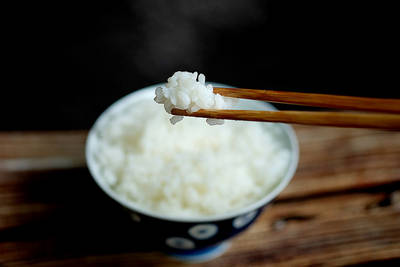
Rice
Rice, served in a bowl, is the quintessential element of any meal in Japan, and not just of a traditional breakfast. It is the main source of carbohydrates in the Japanese diet. Most people use the rice cooker for preparation. The rice is first washed to release excess starch, and then boiled until the center of the rice becomes soft. Nothing else is added during cooking, not even salt. Modern rice cookers include a timer to start cooking at a set time. This function is widely used in Japanese families for breakfast, setting the rice cooker the night before in such a way as to find the rice ready for breakfast when you wake up the next morning.
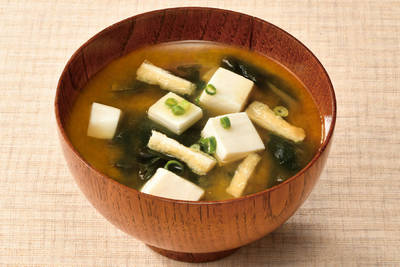
Miso soup
Miso soup and rice are the ever-present dishes of the traditional Japanese breakfast. Miso soup is made by boiling a number of ingredients in hot water or dashi broth and then dissolving the miso paste inside. Typical ingredients for miso soup are tofu and wakame seaweed, and recipes vary between regions or families, and can include different types of vegetables. The soup is usually served in lacquer bowls with lids and is drunk straight from the bowl, although the solid ingredients can be eaten with chopsticks. There are many types of miso sold in supermarkets, but for the lazy there is also instant miso soup, available in supermarkets in single-serving packs, and that can be made in minutes by reconstituting dehydrated miso powder and dried toppings such as wakame and tofu in a little hot water.
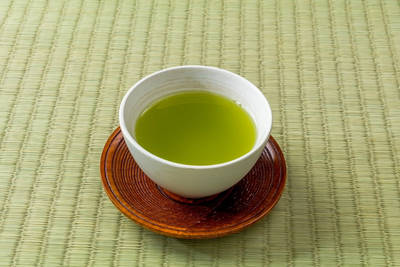
Hot tea
Hot tea is the standard drink served for breakfast, mostly green tea. But be careful not to confuse green tea with matcha tea. There are different types of green tea, and matcha is just one of them, but it is rarely drunk for breakfast, the
sencha green tea is preferred. However, as strange as it may seem, tea is not an essential element of the traditional Japanese breakfast, as the main source of liquids in the meal is miso soup.
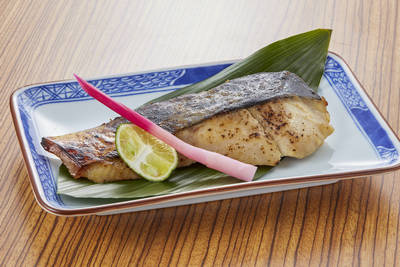
Grilled fish (yakizakana)
A small piece of grilled fish is a common element in Japanese breakfasts and is generally served seasoned. There are many types of fish cooked for breakfast, the most common being mackerel, horse mackerel and salmon. Yakizakana is cooked in a simple way, simply by sprinkling whole fish or a fish fillet with salt and grilling it. Grilled fish goes well with rice and is often eaten together, taking a piece of fish and bringing it to the rice bowl, then eating fish and rice in one bite.
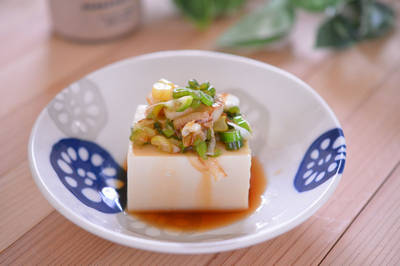
Tofu
Tofu is often served for breakfast and in different ways. As mentioned with regard to miso soup, tofu is one of the most popular ingredients boiled together with soup. Alternatively, tofu can be served on a separate plate, for example as
hiyayakko, a tofu recipe flavored with soy sauce, green onion and katsuobushi (dried fish flakes).
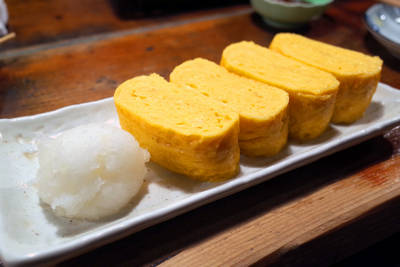
Eggs
Eggs can be served in a variety of ways and are very popular with Japanese people for breakfast. The most popular and delicious way is
tamagoyaki, a type of Japanese omelette that is made by repeatedly laying beaten eggs in a hot square pan and then rolling it. Soy sauce, mirin and sugar are added to flavor the eggs, giving them a unique sweet taste. Alternative versions of this dish include
dashimaki tamago, where dashi broth is added to the egg mix making the tamagoyaki salty and not sweet. Another way to serve eggs for breakfast is the so-called
onsen tamago, that is an egg boiled at about 65 degrees (preferably in thermal water), obtaining a creamy and partially congealed egg white and a just thickened yolk. Of course, simple fried or scrambled eggs can sometimes be served as well. Finally, some restaurants may serve you a raw egg (at first glance you might think it's a hard-boiled egg to peel, but it's not). The Japanese usually break the raw egg shell directly on the rice bowl and then mix the yolk and egg white with the rice and eat it all together, perhaps adding a dash of soy sauce.
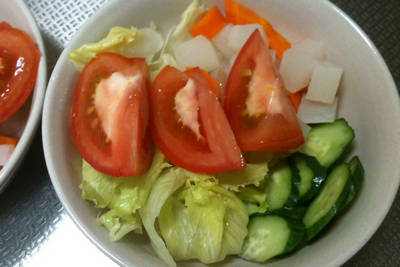
Vegetables
Vegetables are often served in separate plates with seasonal vegetables cooked in a simple way, or as a salad. Among the most common are cabbage, lettuce, tomato, daikon, cucumber. A particular vegetable-based dish that some Japanese love in the morning (and beyond) is
ohitashi, a dish in which vegetables are dipped in a dashi-based sauce. Spinach are very popular as an ingredient for oitashi.
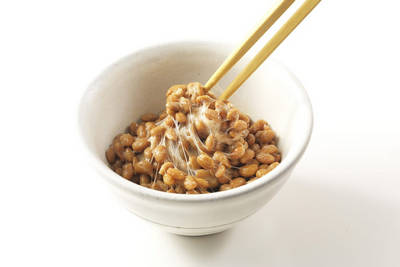
Natto
Natto is one of the most controversial foods of the Japanese tradition, not much loved by foreigners. These are fermented soybeans that take on a sticky, almost slimy consistency, and a very strong smell. It is often flavored with Japanese mustard (karashi), and many eat it over rice. In Japan, natto is considered, with good reason, an incredibly healthy dish, being rich in proteins and other nutrients, and also promotes digestion thanks to the probiotics that are formed with the fermentation process. You can buy it in any supermarket in ready-to-eat trays.
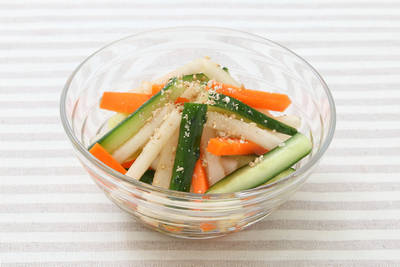
Pickles (tsukemono)
All Japanese meals, from breakfast to dinner, are often accompanied by a small bowl of different pickled vegetables, called tsukemono in Japanese. These have the function of appetizers, digestives and cleansing the palate. Common varieties of breakfast pickles include pickled daikon (takuan) and pickled plums (umeboshi), but many other vegetables can be used.
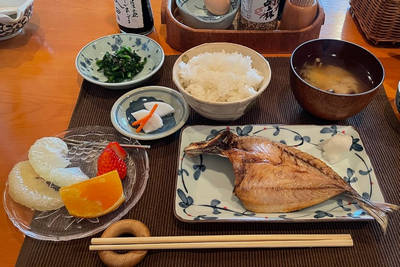
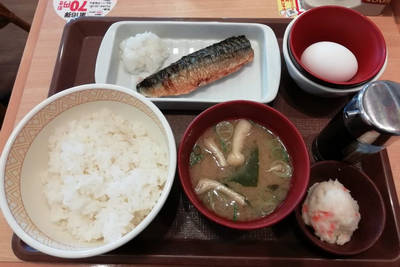 various types of traditional Japanese breakfast sets
various types of traditional Japanese breakfast sets
What Japanese people really eat for breakfast
If you are wondering if every day the Japanese start their day by eating everything described in the paragraph above, the answer is no. Over the last few decades, two factors have changed Japanese breakfast habits. On the one hand, western influence certainly played a role, in fact for many Japanese breakfast has become an opportunity to eat something very different from lunch or dinner, an opportunity to add variety to an otherwise rice-based diet. On the other hand, the change in society and in particular the collapse of marriages, the increase in the number of singles, and the emancipation of women who are increasingly no longer a housewife, have made it more and more difficult to continue with a traditional breakfast that takes a long time to prepare and also to be eaten. So don't be surprised if many Japanese at home have a quick breakfast with milk, cereal, yogurt, bread, or grab a sandwich in a konbini or something sweet in one of the many cafes and bakeries. That said, the traditional Japanese breakfast is still very popular, especially in families where someone in the house has the time to prepare the rice, miso soup and the other dishes mentioned above. In summary, if it is true that more and more people in Japan have a breakfast based on bread products (62% according to a 2018 survey), it is also true that for the majority of Japanese people, the traditional breakfast continues to be the best, and it is mainly the convenience factor that pushes many people to eat something more hasty (and then more western) in the morning.
Where to try traditional breakfast in Japan
Thankfully, you don't need to have a Japanese mother or wife to try the country's traditional breakfast. As a tourist, you will be spoiled for choice as to where to go.
In restaurants
In all corners of Japan there are chains of restaurants open even in the morning with a dedicated "breakfast menu", generally available until 10 or 11 am. Very popular are in particular some low-cost restaurant chains, where you can have breakfast for less than 1000¥ and sometimes even less than 500¥:
In a ryokan
Most ryokans serve charming traditional breakfasts that consist of multiple dishes and include local and seasonal specialties, accompanied by rice and miso soup. Someone objects, not without reason, that the breakfast served today by many ryokans is not traditional in the strict sense, as the traditional one is based on very simple dishes, while in ryokans they often serve a breakfast which is more a kaiseki-style reinterpretation of traditional breakfast. This, however, makes breakfast served in ryokans even more fascinating and is an experience recommended to anyone at least once in their life.
In hotels
In most hotels in Japan, breakfast is offered as a buffet. In any buffet, regardless of the level of the hotel, you will find traditional Japanese breakfast dishes. What differentiates a high-end hotel from a more modest hotel is, on the contrary, the offer of non-typically Japanese products, such as cereals, biscuits, bread, sausages, bacon, baked goods and pastries, but also Chinese and Korean food. Conversely, rice, miso soup, grilled fish, eggs, salads, and Japanese-style side dishes can be found in any hotel breakfast buffet. Finally, even if you are staying in a hotel that does not offer breakfast, keep in mind that you can still try one morning to have breakfast at a large hotel, perhaps nearby. In many hotels, breakfast is also open to external customers and can cost between 1500 and 3000 yen depending on the level. You don't have the money to stay in that beautiful hotel down the road but you are staying in a capsule hotel? No problem, you can at least take away the whim of having breakfast one morning with a luxurious buffet.
Guided tours, activities and other things to do
If you are planning a trip to Japan and you want to do something more than just visiting famous places and monuments, we suggest you to use Rakuten Travel Experiences.
How to use Rakuten Travel Experiences
Rakuten Travel is a very useful website to enrich your travel experience, especially if you are going solo or it's your first time in Japan.
Because of the language barrier (and more), in Japan it is very difficult to interact with the locals and to get off the tourist track.
Thanks to Rakuten Travel you can find a lot of interesting and sometimes unique guided tours and activities all over Japan (and not only in Japan), that you would otherwise never be able to enjoy.
But there's more: on Rakuten Travel you can also buy tickets for several famous attractions, events, transportation and other useful services for tourists. Last but not least, you can reserve a table in hundreds of restaurants.
Some examples
Take a look at Rakuten Travel Experiences
You may also be interested in








